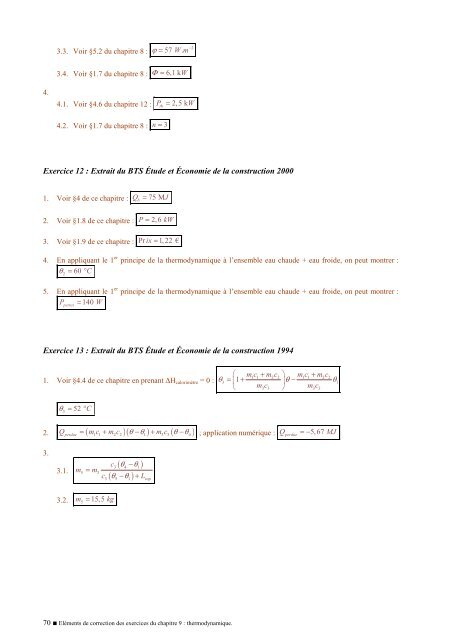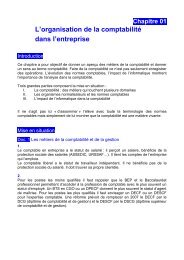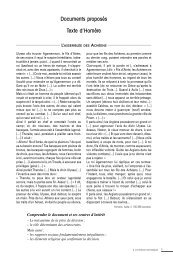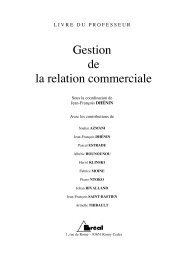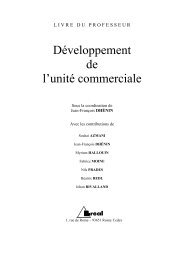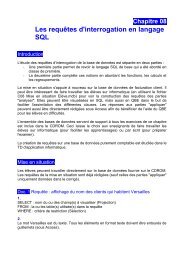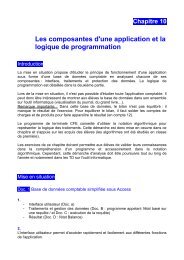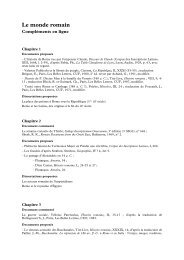correction exercices Précis de Physique-Chimie chapitre 5 à 9
correction exercices Précis de Physique-Chimie chapitre 5 à 9
correction exercices Précis de Physique-Chimie chapitre 5 à 9
You also want an ePaper? Increase the reach of your titles
YUMPU automatically turns print PDFs into web optimized ePapers that Google loves.
3.3. Voir §5.2 du <strong>chapitre</strong> 8 :<br />
ϕ = 57 W.<br />
m<br />
−2<br />
3.4. Voir §1.7 du <strong>chapitre</strong> 8 : Φ = 6,1 kW<br />
4.<br />
4.1. Voir §4.6 du <strong>chapitre</strong> 12 : P = 2,5 kW<br />
th<br />
4.2. Voir §1.7 du <strong>chapitre</strong> 8 : n = 3<br />
Exercice 12 : Extrait du BTS Étu<strong>de</strong> et Économie <strong>de</strong> la construction 2000<br />
1. Voir §4 <strong>de</strong> ce <strong>chapitre</strong> : Q = 75 MJ<br />
2. Voir §1.8 <strong>de</strong> ce <strong>chapitre</strong> : P = 2,6 kW<br />
3. Voir §1.9 <strong>de</strong> ce <strong>chapitre</strong> : Pr ix = 1,22 €<br />
b<br />
4. En appliquant le 1 er principe <strong>de</strong> la thermodynamique à l’ensemble eau chau<strong>de</strong> + eau froi<strong>de</strong>, on peut montrer :<br />
θ<br />
2<br />
= 60 ° C<br />
5. En appliquant le 1 er principe <strong>de</strong> la thermodynamique à l’ensemble eau chau<strong>de</strong> + eau froi<strong>de</strong>, on peut montrer :<br />
= 140 W<br />
Ppertes<br />
Exercice 13 : Extrait du BTS Étu<strong>de</strong> et Économie <strong>de</strong> la construction 1994<br />
1. Voir §4.4 <strong>de</strong> ce <strong>chapitre</strong> en prenant ∆H calorimètre = 0 :<br />
θ ⎛<br />
1 1 2 2 1 1 2 2<br />
3<br />
1 m c + m c ⎞ m c m c<br />
1<br />
m3c<br />
θ +<br />
= ⎜ + ⎟ −<br />
3<br />
m3c<br />
θ<br />
⎝<br />
⎠<br />
3<br />
θ<br />
3<br />
= 52 ° C<br />
2. Q ( m c m c )( θ θ ) m c ( θ θ )<br />
perdue<br />
= + − + − ; application numérique : Q = − 5,67 MJ<br />
1 1 2 2 1 3 3 4<br />
perdue<br />
3.<br />
3.1.<br />
c3 ( θ4 −θ1<br />
)<br />
( θ − θ ) +<br />
m5 = m3<br />
c<br />
3 5 1 L<br />
vap<br />
3.2. m5 = 15,5 kg<br />
70 ■ Eléments <strong>de</strong> <strong>correction</strong> <strong>de</strong>s <strong>exercices</strong> du <strong>chapitre</strong> 9 : thermodynamique.


